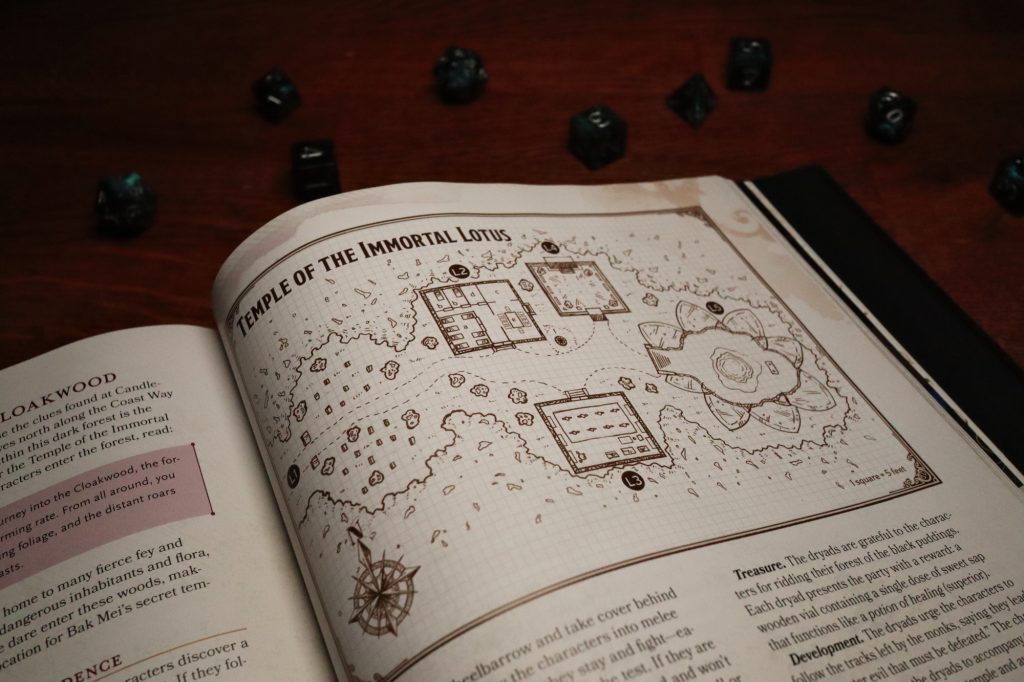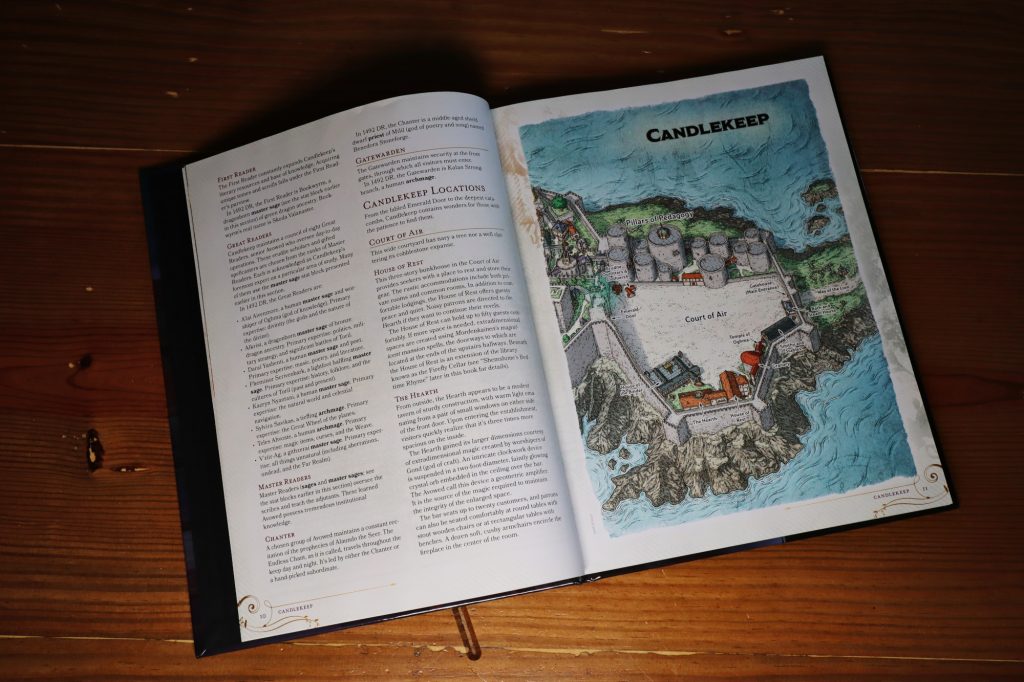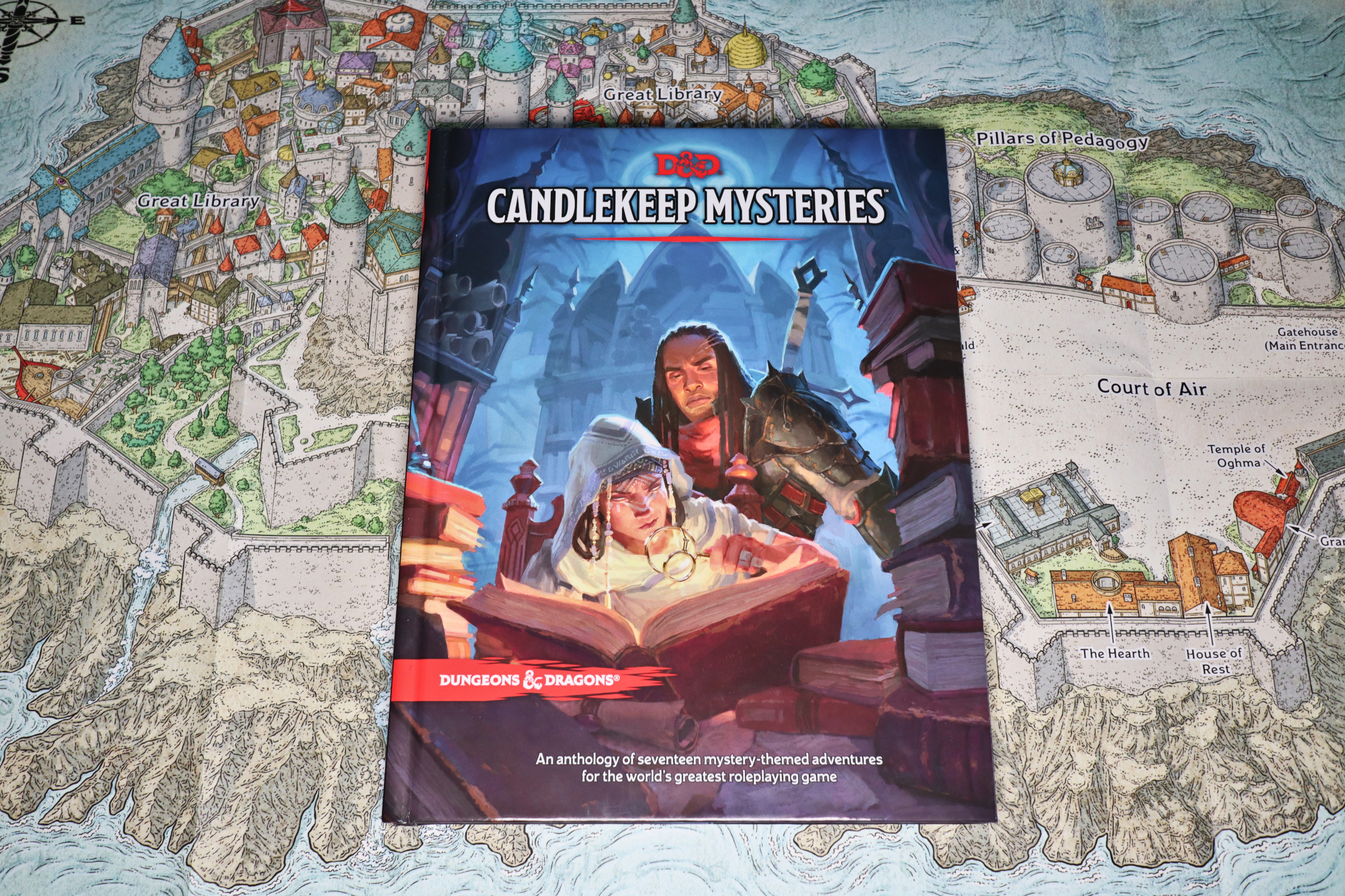Candlekeep Mysteries is the brand new Dungeon & Dragons adventure book from Wizards of the Coast. In a change from the norm, this isn’t a single adventure, instead 17 separate adventures linked to books and the Candlekeep library are included. Each adventure is written by a different author, including Graeme Barber, Kelly Lynne D’angelo, Alison Huang and Mark Hulmes. There is an adventure for adventuring parties from level 1 characters through to level 16, with two included for level 4. However, is this a brilliant collection of adventures or an odd mixture? Let’s find out!
Each of the adventures starts with players finding a book, be that after searching the Candlekeep Great Library for a specific topic with a guide or stumbling across a book. The book itself may contain a passage of important text, though the book may just have a map poking out from it’s pages. It might see the adventuring party need to travel to a location or it might just instantly transport them somewhere. Each adventure is it’s own, self contained, adventure ready to be played or adapted by Dungeon Masters (DMs).
Candlekeep Mysteries isn’t like most adventure books. From the offing it sets itself up to be a guide for DMs, a tool for them to use, but not one to simply follow. Not to be confused with a loose plotline, the entire book is written in a way that a DM can take any of the adventures and use them in their own campaigns. At the start of the adventure book it literally says: “Nothing in these adventures is too sacred to tamper with and repurpose to serve your own needs”.
The concept of each adventure beginning with a book, or something within a book, is ideal for this. The adventure book suggests replacing Candlekeep’s library location with an appropriate one from a non Forgotten Realms setting (The Library of Korranberg in the world of Eberron for example). However, individual books could just as easily be found in the clutches of a downed foe, catching the eye of adventurers from a bookcase or even dropped onto the party’s table in a tavern.

As with any written adventure DMs will want to steer their players at times to fully experience the content. Adventurers obviously don’t know what’s written and what is important, and at times will want to barrel straight through the next door. In a couple of the adventures, such as in The Scrivener’s Tale, players could rush through and get to the final encounter. While this is what some players will want to do, others will want the coaxing drawing them away from the “final” door of the dungeon. Allowing them to delve into some of the awesome details they’d otherwise had missed, from a deep spring to a different room of monsters to fight. Thankfully, a simple locked door, with the adventuring party needing to locate a hidden key, can do the trick nicely.
Each of the chapters being distinct stories, and enclosed in their chapters are also the magic items and stat blocks for the new monsters. This is a bit of a break from the norm, which often sees these appear as appendices in adventure books. Having all of the included monsters at the back of the adventure books makes it easy to find the ones you want – even when not running the specific adventure. Wizards of the Coast may be testing the water with Candlekeep Mysteries in this regard. It’s a trade off. It is helpful during the adventure to have it included in the adventure text but not when just wanting to use the monster later on.
Impressively each adventure feels different, with aspects of exploration, investigating, combat and more taking the front and backseats. DMs can pick the adventures out that will strongly appeal to the players around the table. Conversely, they can use these 1 – 2 session long adventures to break from the norm – perhaps not solely being combat focused for once. Falling into a rut with the playstyle can happen during longer campaigns, so having a breather via a refreshing change even briefly can work wonders.
While each adventure starts in a similar way, they all offer an idea of what could happen next. Some of these are based upon player choices during the adventure, with others just a possible way to let a location or something become a recurring feature of a campaign. This can be used nicely to link the stories together, or branch off out of the book to make a one shot session into something longer.

Candlekeep itself is an interesting location, which is given enough love in the book that adventurers can comfortably find themselves constantly returning to, and finding something new each time. The mysteries in the books are all individual but it is Candlekeep itself that could draw them all together into a campaign. From the cost of a book to enter, to the various spells that protect the library from fire and theft: there are even parts that most of the Avowed cannot snoop around – let alone the players. It is almost a shame that many players won’t get to fully experience Candlekeep, with the adventure book seemingly being aimed towards one shots and using content in any setting.
It would have been nice to see a slight skew towards lower level adventures. The adventures are ideal at letting new players try D&D, as within one or two sessions they will have completed a full, well written, adventure. The adventure book does suggest swapping in and out monsters, or adapting DCs. It is often easier though to add monsters into the mix, rather than remove them and still maintain the thrill of an adventure.
Another aspect pointing towards it being an adventure book for newer DMs/players is that some of the alignment details are gone. Alignments can be useful to determine a rough style when NPCs fight but for the most part the feature does seem to be slipping out of importance. By not including it in certain cases it becomes one less thing for new DMs to think about. It would be nice to see alignments included for those that want them, though it isn’t much of a loss. A nice touch is that some of the NPC roles, such as for the sage in Candlekeep, have no predetermined gender or race, making it a touch easier to have a miniature ready for them and lets them fit into any setting easier.
Included at the back of the book is a poster map, which players can tear out and unfold. It’s a detailed map of Candlekeep and surprisingly shows more than the map within the book. At the start of the book only half of Candlekeep’s map is visible, with the Inner Ward area that includes the Great Library itself not shown, which seems an oversight. Having the poster doesn’t entirely fix this issue. With a poster map and the full map in the book the DM could have passed the poster across to the players, or left it in a way they could all see it. If the DM does this with Candlekeep they will either have to then ask for it back or refer to only half of the map from the book. As the rest of the adventure book seems to attempt to make playing the content so easy this just stands out.
From the illusions present in The Price of Beauty to an entire abandoned mining town in A Deep and Creeping Darkness, Candlekeep Mysteries is an epic collection of short adventures. Not every adventure and not every group will find them to be single session adventures, but they can be used and adapted to fit any purpose. From giving a break in an overarching plot to introducing new players to Dungeons & Dragons, Candlekeep Mysteries is a book for many DMs. Being a collection from so many different writers it is impressive there is still a narrative of Candlekeep itself drawing them all together. There are plenty of hours of interest, unique locations to explore and even secrets that could spill out into full campaigns ready to be enjoyed!
(Editor’s Note: Candlekeep Mysteries was provided to us by Asmodee for the review. The adventure book is currently available from local board game stores! Find your local store here.)

